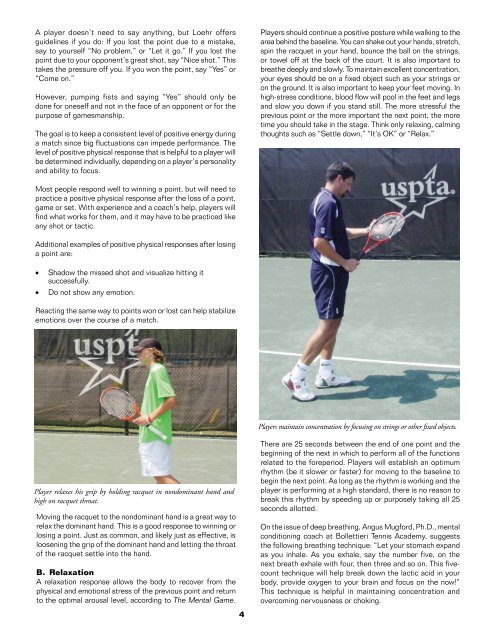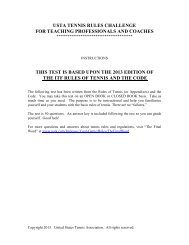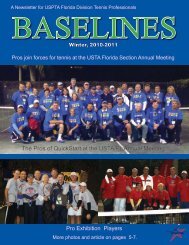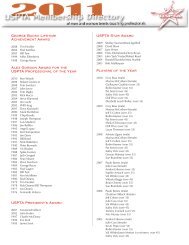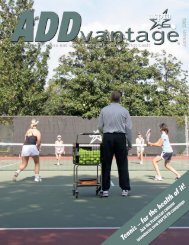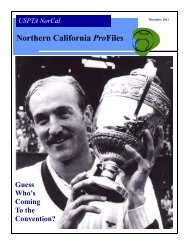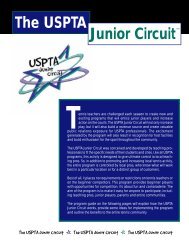Volume 2, No. 3 - United States Professional Tennis Association
Volume 2, No. 3 - United States Professional Tennis Association
Volume 2, No. 3 - United States Professional Tennis Association
Create successful ePaper yourself
Turn your PDF publications into a flip-book with our unique Google optimized e-Paper software.
A player doesn’t need to say anything, but Loehr offers<br />
guidelines if you do: If you lost the point due to a mistake,<br />
say to yourself “<strong>No</strong> problem,” or “Let it go.” If you lost the<br />
point due to your opponent’s great shot, say “Nice shot.” This<br />
takes the pressure off you. If you won the point, say “Yes” or<br />
“Come on.”<br />
However, pumping fists and saying “Yes” should only be<br />
done for oneself and not in the face of an opponent or for the<br />
purpose of gamesmanship.<br />
The goal is to keep a consistent level of positive energy during<br />
a match since big fluctuations can impede performance. The<br />
level of positive physical response that is helpful to a player will<br />
be determined individually, depending on a player’s personality<br />
and ability to focus.<br />
Players should continue a positive posture while walking to the<br />
area behind the baseline. You can shake out your hands, stretch,<br />
spin the racquet in your hand, bounce the ball on the strings,<br />
or towel off at the back of the court. It is also important to<br />
breathe deeply and slowly. To maintain excellent concentration,<br />
your eyes should be on a fixed object such as your strings or<br />
on the ground. It is also important to keep your feet moving. In<br />
high-stress conditions, blood flow will pool in the feet and legs<br />
and slow you down if you stand still. The more stressful the<br />
previous point or the more important the next point, the more<br />
time you should take in the stage. Think only relaxing, calming<br />
thoughts such as “Settle down,” “It’s OK” or “Relax.”<br />
Most people respond well to winning a point, but will need to<br />
practice a positive physical response after the loss of a point,<br />
game or set. With experience and a coach’s help, players will<br />
find what works for them, and it may have to be practiced like<br />
any shot or tactic.<br />
Additional examples of positive physical responses after losing<br />
a point are:<br />
· Shadow the missed shot and visualize hitting it<br />
successfully.<br />
· Do not show any emotion.<br />
Reacting the same way to points won or lost can help stabilize<br />
emotions over the course of a match.<br />
Players maintain concentration by focusing on strings or other fixed objects.<br />
Player relaxes his grip by holding racquet in nondominant hand and<br />
high on racquet throat.<br />
Moving the racquet to the nondominant hand is a great way to<br />
relax the dominant hand. This is a good response to winning or<br />
losing a point. Just as common, and likely just as effective, is<br />
loosening the grip of the dominant hand and letting the throat<br />
of the racquet settle into the hand.<br />
B. Relaxation<br />
A relaxation response allows the body to recover from the<br />
physical and emotional stress of the previous point and return<br />
to the optimal arousal level, according to The Mental Game.<br />
4<br />
There are 25 seconds between the end of one point and the<br />
beginning of the next in which to perform all of the functions<br />
related to the foreperiod. Players will establish an optimum<br />
rhythm (be it slower or faster) for moving to the baseline to<br />
begin the next point. As long as the rhythm is working and the<br />
player is performing at a high standard, there is no reason to<br />
break this rhythm by speeding up or purposely taking all 25<br />
seconds allotted.<br />
On the issue of deep breathing, Angus Mugford, Ph.D., mental<br />
conditioning coach at Bollettieri <strong>Tennis</strong> Academy, suggests<br />
the following breathing technique: “Let your stomach expand<br />
as you inhale. As you exhale, say the number five, on the<br />
next breath exhale with four, then three and so on. This fivecount<br />
technique will help break down the lactic acid in your<br />
body, provide oxygen to your brain and focus on the now!”<br />
This technique is helpful in maintaining concentration and<br />
overcoming nervousness or choking.


